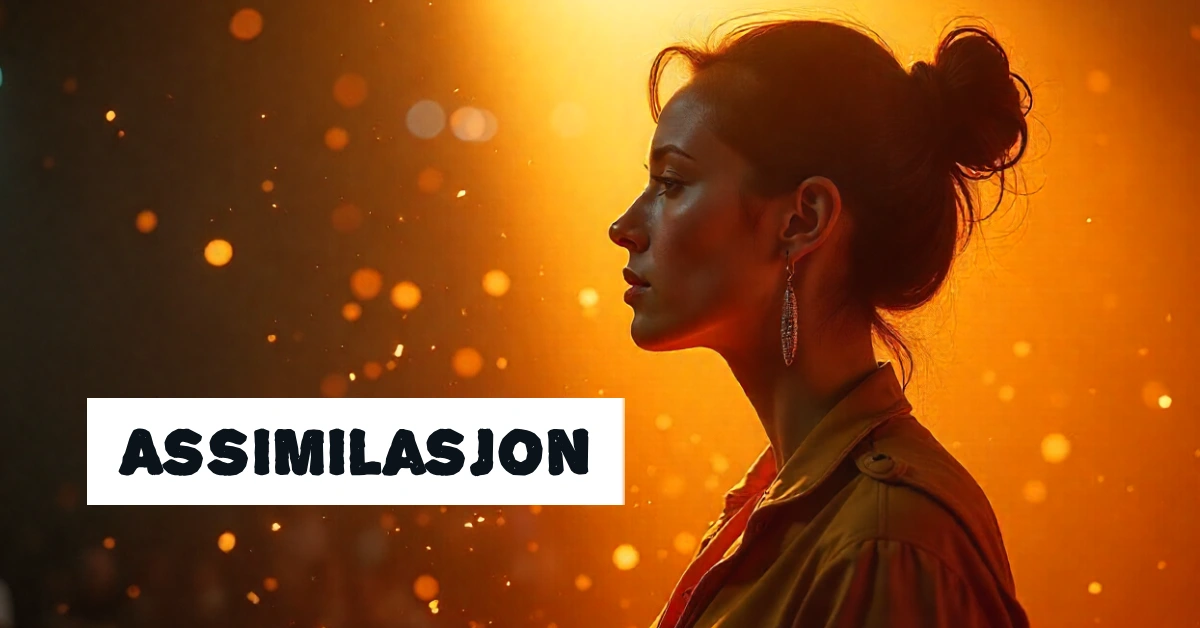The term assimilasjon might look simple on the surface, but it carries centuries of cultural, linguistic, and philosophical weight. Derived from the Latin assimilatio, meaning “to make similar,” this word has traveled across time and disciplines, gathering fresh nuances in every field it touches — from biology and linguistics to sociology and cultural studies. In Norwegian and other Scandinavian languages, assimilasjon retains that same dual quality: a process of blending and becoming alike, yet also one of potential loss, adaptation, and transformation.
But what does it really mean to assimilate? Is it about fitting in, evolving, or erasing difference? Let’s unravel the intricate threads of assimilasjon step by step.
1. The Linguistic Roots of Assimilasjon
In linguistic terms, assimilasjon refers to a phonological process in which one sound becomes more like a neighboring sound. It’s one of the most common and natural patterns in human language. For example, in English, the word “input” is often pronounced as “imput” because the nasal sound /n/ adapts to the bilabial /p/.
In Norwegian phonology, similar shifts occur when sounds “blend” to ease pronunciation. For instance, han spiser (“he eats”) may sound closer to haspiser in rapid speech. Linguists see this as the language’s way of optimizing flow — a form of natural economy where speech seeks efficiency.
This linguistic assimilation is not about loss; it’s about balance. It ensures that communication remains smooth and efficient, adapting to the natural rhythm of human speech.
2. Assimilasjon in Cultural and Social Contexts
Outside the realm of sounds and phonetics, assimilasjon takes on a much deeper — and sometimes controversial — meaning. Social assimilation describes the process by which individuals or groups adopt aspects of another culture, often that of a dominant society.
In multicultural contexts, this process can be voluntary, as in the case of immigrants learning a new language or adopting social norms to integrate better. But it can also be involuntary, forced through political or cultural pressure, leading to the erosion of native identity, language, or traditions.
For instance, during various periods of history, indigenous peoples in different parts of the world were subjected to assimilation policies that aimed to “civilize” them — stripping away languages, customs, and belief systems in favor of those of the colonizers. Norway itself experienced this dynamic, particularly in its historical treatment of the Sámi people, whose language and culture were suppressed in the name of national unity.
Thus, assimilasjon is a double-edged sword: it can mean adaptation and coexistence, but it can also symbolize loss and domination.
3. Assimilasjon vs. Integrasjon: Subtle but Significant
A common confusion arises between assimilasjon and integrasjon. While they might appear interchangeable, their implications differ sharply.
- Assimilasjon implies that one culture absorbs another until the differences fade away. The minority becomes part of the majority, often losing its unique characteristics.
- Integrasjon, on the other hand, suggests coexistence — a blending without erasure. It emphasizes unity while preserving diversity.
Think of assimilation as mixing colors until they become one uniform shade, whereas integration is like a mosaic — different pieces maintaining their individuality while forming a cohesive whole.
Modern societies often advocate for integration over assimilation, valuing multiculturalism as a strength rather than a threat. However, the tension between these concepts continues to shape national identities, immigration policies, and cultural debates worldwide.
4. The Psychological Dimensions of Assimilasjon
Assimilation also plays out in the human mind. In psychology, the term describes the process of absorbing new information into existing mental frameworks. This concept, introduced by Jean Piaget, is paired with its counterpart, accommodation.
- Assimilation occurs when we interpret new experiences through the lens of what we already know.
- Accommodation happens when we modify our mental models to incorporate new information.
For example, a child who has learned the concept of “dog” may initially call all four-legged animals dogs. When corrected, they must accommodate their understanding to recognize cats, cows, and other animals as distinct.
In this sense, assimilasjon represents mental adaptation — our mind’s attempt to maintain cognitive balance. It’s the cornerstone of how humans learn, evolve, and make sense of an ever-changing world.
5. Assimilasjon in Biological Sciences
In biology, assimilasjon describes the metabolic process where nutrients are converted into the tissues and energy of an organism. When you eat food, your body digests and assimilates nutrients — proteins, carbohydrates, and fats — transforming them into energy and cell structures.
This kind of assimilation isn’t about blending identities but about transformation and sustenance. It ensures growth and survival. Every living being, from the simplest bacterium to the human body, relies on assimilation to maintain life.
Here, the word regains its original Latin sense — to make similar. The body takes what is foreign (food) and makes it part of itself. It’s a vivid metaphor for all other forms of assimilation: a process of turning “the other” into “the self.”
6. Political and Ethical Debates Around Assimilasjon
In modern politics, the term assimilasjon is often loaded with emotional and ethical undertones. Some nations historically promoted assimilation as a means of social cohesion, believing it necessary for national unity. Others now see it as an outdated and oppressive concept that disregards cultural identity.
Critics argue that forced assimilation violates human rights, as it demands conformity at the expense of heritage and self-expression. For example, in educational policies that discourage the use of minority languages or traditional dress, assimilation becomes a tool of cultural homogenization.
However, proponents of a “soft assimilation” model suggest that certain shared values — such as democratic principles or linguistic competence — are essential for harmony and participation in civic life. The challenge lies in finding a balance between inclusion and preservation.
7. Assimilasjon in the Age of Globalization
In today’s interconnected world, assimilasjon takes on new forms. Globalization, social media, and migration have blurred cultural boundaries, creating a vast, hybrid global culture. English words creep into Norwegian, K-pop influences Western music, and cuisines blend into new fusion dishes.
This modern assimilation is more fluid, voluntary, and decentralized. Individuals now participate actively in cultural exchange, choosing what to adopt and what to retain. A young Norwegian might wear sneakers from Japan, listen to Afrobeat, and speak in a slang-rich mix of English and Norwegian — not out of coercion, but expression.
The internet has accelerated this trend, turning assimilation into a global dialogue rather than a one-sided process. It’s no longer about losing identity; it’s about reimagining it in broader contexts.
8. The Ethical Balance: Preservation vs. Progress
The heart of the assimilasjon debate lies in balancing preservation with progress. Cultures must evolve to survive, yet they must not erase their roots. True assimilation should not mean destruction but mutual enrichment.
Consider the evolution of languages: Norwegian itself absorbed countless foreign influences — from Old Norse and Low German to French and English — yet retained its unique rhythm and structure. Similarly, human societies thrive when they assimilate knowledge and innovation while safeguarding their essence.
In this sense, assimilasjon can be redefined not as loss, but as growth through inclusion.
9. Assimilasjon in Art and Literature
Artists and writers have long grappled with the concept of assimilation — depicting characters caught between identities, traditions, and expectations. Literature often uses assimilation as a metaphor for transformation, alienation, or belonging.
From immigrant novels that explore the pain of cultural displacement to contemporary art that fuses styles from different heritages, assimilation has become a recurring theme in storytelling. It mirrors the human condition: our constant struggle to belong without disappearing.
Artistic assimilation shows that blending does not always weaken originality — it can also spark innovation. The fusion of diverse traditions has given birth to some of the most powerful creative movements in history, from jazz to modernism.
10. The Future of Assimilasjon
As societies continue to diversify, the meaning of assimilasjon will keep evolving. The next generation may no longer view it as a binary of dominance and submission but as a dynamic process of coexistence and creativity.
With technology enabling cultural dialogue on an unprecedented scale, assimilation might become less about “becoming the same” and more about “learning to live together.” In that world, differences are not barriers but bridges.
Education, art, and digital communities can play a crucial role in shaping this new understanding — where assimilation empowers rather than erases.
Conclusion
Assimilasjon is more than a word — it’s a mirror reflecting humanity’s timeless dance between identity and change. Whether in language, culture, mind, or body, it signifies transformation, adaptation, and the eternal search for equilibrium.
While its history carries shadows of coercion and loss, its essence remains vital to growth. To assimilate, at its best, is to learn, to evolve, and to find harmony in diversity.
In an era where differences often divide us, perhaps true assimilation lies not in uniformity but in understanding — a process through which we recognize ourselves in one another.
FAQs
1. What does “assimilasjon” mean in Norwegian?
It means assimilation — the process of becoming similar or adapting, used in contexts like language, culture, psychology, and biology.
2. How is assimilation different from integration?
Assimilation often implies full absorption into another culture, while integration allows coexistence of distinct identities within one society.
3. Is assimilation always negative?
Not necessarily. While forced assimilation can harm cultural identity, voluntary assimilation can foster growth, understanding, and unity.
4. How does assimilation occur in language?
Through phonological changes where sounds adjust to neighboring ones, making speech smoother and more efficient.
5. What’s an example of assimilation in everyday life?
When people adopt certain customs, slang, or cuisines from other cultures while interacting in a globalized world — consciously or unconsciously.

